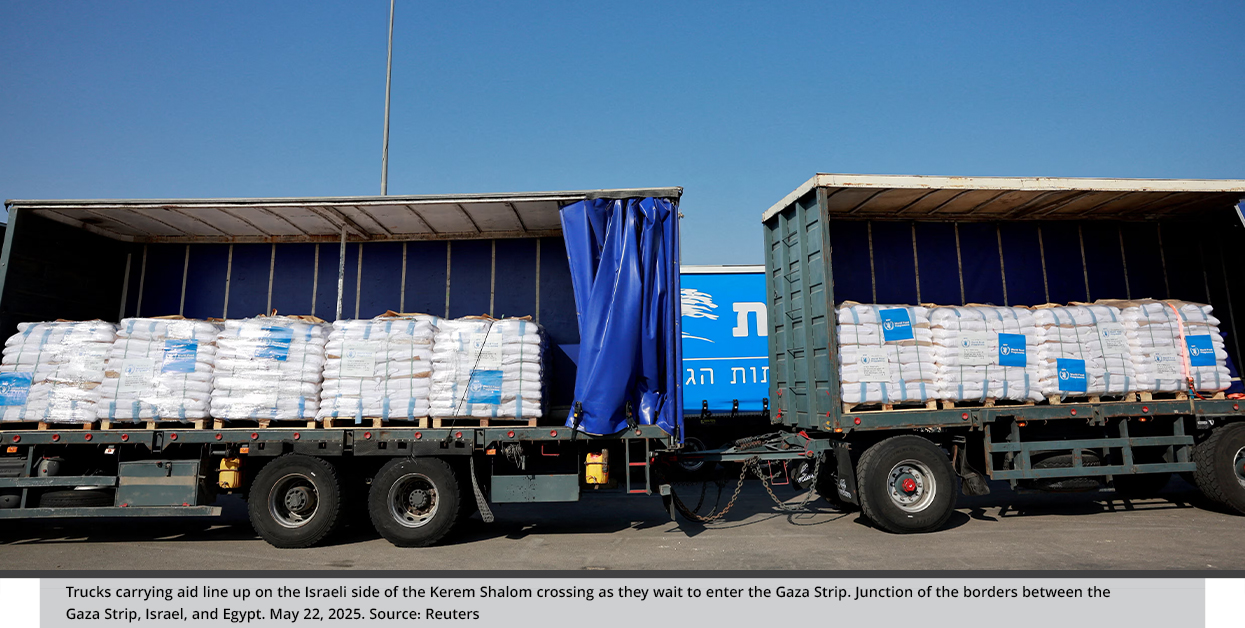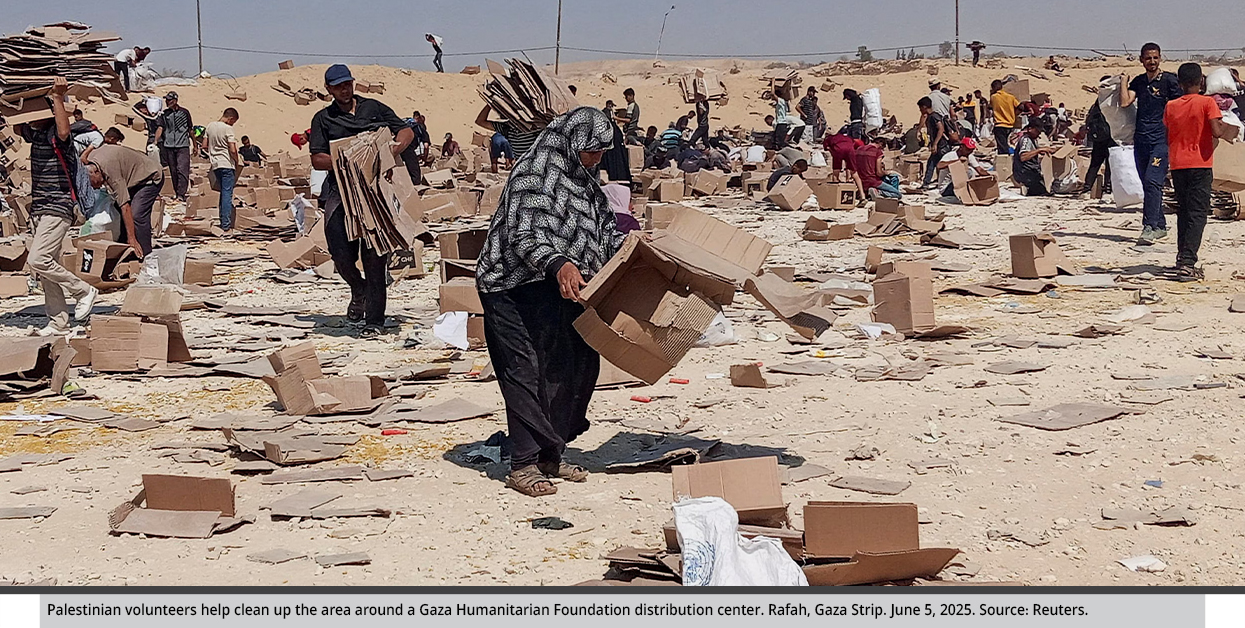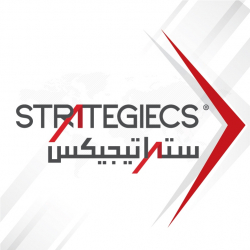The Gaza Humanitarian Foundation’s Role in the Post-War Gaza Equation
The humanitarian landscape in the Gaza Strip is undergoing a significant transformation with the launch of the Gaza Humanitarian Foundation (GHF). Overseen by former U.S. military officers, the GHF provides aid and security to support the Israeli strategy of dismantling Hamas’s rule and reshaping governance in the Strip. Amid the declining role of UN agencies, the GHF has emerged as an invaluable tool for reengineering the population landscape through projects such as the "Humanitarian City" and “Safe Bubbles”.
by STRATEGIECS Team
- Release Date – Jul 20, 2025

The humanitarian landscape and relief efforts in the Gaza Strip are undergoing a profound transformation with the launch of the Gaza Humanitarian Foundation (GHF) in May 2025—a precedent that reflects an unprecedented expansion in the role of private institutions and security companies in the humanitarian file. This shift represents a practical embodiment of one of the key features of the “day after the war” scenario, and it highlights the mounting pressure on Hamas, which had previously opposed Israel’s attempts to establish alternative actors for aid distribution and security enforcement.
Overall, the people of Gaza are facing an unprecedented humanitarian crisis that has led to near-total dependence on foreign aid. This aid is no longer merely a humanitarian response—it has become a highly complex component of the war landscape, where military considerations are entangled with political objectives. As such, humanitarian aid is now directly linked to the course of the conflict between Israel and Hamas while serving as a model for the emerging post-war reality in the Gaza Strip.
The GHF: Operational Capabilities and Challenges
The GHF began its operations amid a series of direct and indirect developments related to the ongoing war in the Gaza Strip. Its launch coincided with Israel’s initiation of the large-scale “Gideon’s Chariots Operation” on May 18, 2025, following the Israeli army’s resumption of combat in Gaza on March 17. This escalation came as a result of the stalled transition to the second phase of the ceasefire agreement reached earlier this year on January 19.
The GHF was established in February 2025 and began its operations in May as part of a U.S.-led solution to the dire humanitarian conditions facing the residents of the Gaza Strip. These conditions had worsened significantly after Israel imposed a comprehensive blockade of all goods into the entire Strip on March 2 and one week later cut off all electricity to the area, which Israeli Energy Minister Eli Cohen’s announced on March 9. This effectively stopped all UN and affiliated agency operations from delivering aid, paving the way for the GHF to step in as their replacement, operating under a different mechanism two months later.
The GHF’s model is based on the establishment of distribution points in four designated areas known as Secure Distribution Sites (SDS), each with a capacity to serve approximately 300,000 people. Former U.S. military and intelligence personnel, operating under direct Israeli supervision, are tasked with maintaining security at the checkpoints and distribution hubs.
Since the start of its operations, the GHF has faced significant challenges and criticisms. By late May, scenes of chaos erupted at the distribution points as thousands of Gazans stormed the supply depots after discovering that the distributed aid was limited. This initial experience exposed the GHF and its security personnel’s inability to maintain order, despite relying on armed personnel with military backgrounds.
Moreover, it revealed that access to the aid points was unsafe. Crowds at the distribution hub in the Al-Mawasi area of Rafah were shot at by Israeli drones. According to the UN High Commissioner for Human Rights, approximately 651 Palestinians were shot and killed while attempting to reach aid near the GHF’s sites between late May and July 7.
As a result, the GHF faced a sharp wave of criticism from the United Nations. UN-affiliated agencies refused to cooperate with the GHF, citing violations of neutrality, independence, and humanity in aid distribution. The Humanitarian Country Team in the Occupied Palestinian Territory issued a statement condemning the GHF as part of an Israeli military strategy that contradicts humanitarian norms and aims to tighten control and promote further “forced displacement.”
By early July, more than 170 international humanitarian organizations—including Doctors Without Borders, Oxfam, and Amnesty International—demanded the termination of the GHF’s activities and called for a return to UN-coordinated humanitarian efforts.

Humanitarian Aspects and Tactical Political Dimensions
The launch and operation of the GHF took place within an extended and complex context of Israeli measures in which humanitarian aid became a tool to gain political and tactical military objectives. Thus, aid distribution became deeply embedded in a broader Israeli approach.
Just two days after Hamas launched its attacks on settlements and military bases in the Gaza envelope, Israel imposed its first full blockade on the Gaza Strip. On October 9, 2023, former Israeli Defense Minister Yoav Gallant announced a complete halt to the any food, fuel, and medical supplies being delivered to the Strip, as well as the cutting off its electricity and water supplies.. Although the intensity of this approach fluctuated under international pressure, humanitarian aid consistently remained a component of Israel’s political strategies and military operations.
Israel’s plans—such as the “Day After Hamas” document approved by the Israeli Cabinet in late February 2024—included provisions for establishing safe zones within the Gaza Strip and replacing the United Nations Relief and Works Agency (UNRWA) with alternative humanitarian agencies.
Most subsequent Israeli measures and plans aligned with this document, including the “Generals’ Plan” approved by the Israeli Security Cabinet on February 22, 2024. Israel was accused of implementing this plan seven months later during its military operation in the far north of the Gaza Strip on October 22 when it restrictied the entry of humanitarian aid into combat zones and cut off water and electricity as part of a strategy to pressure Hamas fighters into surrendering or facing famine. This approach escalated six days later when the Knesset passed a resolution on October 28 banning the UNRWA from operating—culminating in the May 2025 launch of both “Operation Gideon’s Chariots,” a major ground offensive against Hamas, and the Gaza Humanitarian Foundation activities in the Strip.
In reality, Israel’s objectives behind restricting the entry of humanitarian aid appear clearly defined. On the negotiation front, Israel has used this issue as a direct pressure tool against Hamas, attempting to complicate the group’s negotiating position by pitting it directly against the needs of the Gazan people—thus pushing it toward accepting Israeli conditions, chief among them the release of hostages held by the group.
This tactic, combined with the massive use of force and the widespread destruction caused by the war, has led to a gradual shift in Hamas’s demands since the October 2023 attacks. Whereas the movement had initially demanded the release of all Hamas prisoners and a complete end to the blockade imposed on Gaza since 2007, its current priorities have come to focus on ensuring the entry and securing the delivery of sufficient and varied humanitarian aid to all areas across the Strip.
As the humanitarian crisis deepened and military operations persisted, social pressure inside Gaza grew into a public demand that the movement show greater flexibility in its stance—even if only temporarily. These pressures culminated in the March 2025 public protests, an unprecedented event that marked a notable shift in public sentiment. For the first time since the war began, demonstrators directly criticized Hamas and called on it to end the war—an unprecedented development in Gaza’s streets.
At a broader strategic level, Israel seeks to use humanitarian aid as a tool to achieve its primary objective: the complete elimination of Hamas and the dismantling of its ideological and organizational structure while simultaneously tightening its absolute control over the Gaza Strip. Thus, Israel denies Hamas any role in the distribution or supervision of aid, especially since it has become a cornerstone for the survival and sustainability of the Gazan population.
In this context, Israel is also working to reshape the roles of international actors in the humanitarian landscape within Gaza, aiming to gradually reduce the role of UN agencies and replace them with private security companies it can control. These companies could, in the future, play a larger role in implementing Israeli policies on the ground. This shift reflects Israel’s awareness of the complexities involved in a direct presence within Gaza, pushing it to rely on alternative tools that are more flexible, less costly, and less risky for managing the post-war reality according to its vision.
Dimensions of Security and Aid Privatization
Israel is facing complex and interlinked challenges regarding occupation and alternative administration. There is widespread concern among the Israeli elite that direct military control over the Gaza Strip could drag the Israeli army into a prolonged war of attrition against Hamas fighters. With their knowledge of hidden weapons storage sites and tunnels that remained undiscovered during the conflict, these fighters could continue operating without a central command structure, even if the movement and its organizational infrastructure are dismantled.
This guerrilla-style warfare tactic has become increasingly evident at this stage, especially given the possibility that Israel is now conducting its final large-scale military operations. Intelligence assessments indicate that the Khan Younis Brigade is the last active and organized Hamas brigade in the Strip.
On the other hand, Israel realizes that remaining in the Gaza Strip entails taking on the responsibility of overseeing security within the Gazan society. Given that the army's core function revolves around the use of lethal force, there is widespread skepticism about its ability to manage a population suffering from unprecedented deprivation without resorting to deadly force. This concern was exemplified by the chaos that erupted at an aid distribution point in the Al Mawasi area of Khan Younis, where six Palestinians were killed after security forces failed to control the crowds.
This means that for Israel to achieve its objectives, it is faced with a single viable option: finding a third party capable of interacting with the population, managing security, and protecting humanitarian aid. This would spare both civilians and the Israeli army the consequences of direct engagement with one another.
Israel has explored several third-party options, most notably through Gallant’s initiative to establish a multinational Arab force tasked with securing aid and maintaining security in Gaza under American supervision. However, Arab states rejected the initiative, condemning it as lacking any comprehensive vision for ending the war or paving the way for the establishment of an independent Palestinian state—while serving as a security umbrella to shield questionable Israeli operations.
As a result, Israel turned to alternative local options by opening communication channels with certain Palestinian tribes in Gaza. However, its first attempt in April 2024 failed after Hamas threatened retaliatory action. A second attempt with Popular Forces, a local militia led by Yasser Abu Shabab in Rafah, failed as they were found to lack the necessary influence and authority to challenge Hamas or maintain security.
With the lack of viable alternatives, Israeli discourse increasingly shifted toward the privatization of security and aid in Gaza—specifically by assigning roles for private security companies in ensuring social order related to aid distribution. This approach first emerged in May 2024 when the Israeli government began discussions with American security firms about managing the Rafah crossing. The idea gained further traction as the Israeli government considered granting a private U.S. firm that provides logistical expertise for complex humanitarian emergencies, the Global Delivery Company, responsibility for maintaining order in northern Gaza following October 2024.
Elements of this strategy were partially implemented during the January 2025 ceasefire when armed personnel from private security firms were tasked with inspecting returnees to the north. The model was later expanded during the recent operations of the GHF, where security contractors played a more visible role in managing aid-related logistics.

However, the prospect of applying these experiences across the entire Gaza Strip and its sprawling population appears highly unlikely—particularly given the limited capacity of private security firms to maintain stability and the absence of any precedent demonstrating their ability to govern a society of Gaza’s scale, especially amid such an unprecedented humanitarian crisis and severe lack of basic infrastructure.
This implies that the society these companies are expected to secure—using a relatively limited number of armed personnel—must be demographically and geographically different from Gaza’s current state. It is within this context that recent Israeli initiatives, such as the “humanitarian bubbles,” can be better understood. These involve establishing protected zones for aid delivery along with the “humanitarian city” project that the Israeli military plans to build in Rafah—an initiative revealed by Israeli Defense Minister Israel Katz in July 2025. Both initiatives heavily rely on surveillance technologies and security screening that aligns with the operational limits and structural nature of private companies managing Gaza’s postwar society.
Conclusion
The growing complexity surrounding the distribution and security of humanitarian aid—alongside the emergence of the GHF—is not separate from Israel’s broader strategy to dismantle Hamas’s rule in the Gaza Strip. Conversely, Hamas is striving to preserve its administrative role, which has increasingly come to revolve around overseeing the flow of aid and ensuring its delivery.
The humanitarian aid scene is no longer merely a political tool or a bargaining chip. It has evolved into a source of pressure on the people of Gaza and a strategic instrument aimed at directing the population into narrow, designated zones—effectively paving the way for a scenario of forced or voluntary displacement under the guise of humanitarian relief.

STRATEGIECS Team
Policy Analysis Team
 العربية
العربية